International Diploma in Anti-Money Laundering - Compliance Framework
VerifiedAdded on 2022/08/30
|16
|3959
|15
Homework Assignment
AI Summary
This assignment addresses key aspects of anti-money laundering (AML) within the context of international finance. It begins by emphasizing the increasing importance of sanctions screening in a complex global business environment, highlighting the need for comprehensive programs, compliance frameworks, and advanced transaction monitoring systems. The assignment then delves into the role of the Office of Foreign Assets Control (OFAC), outlining its functions, sanctions lists, and enforcement mechanisms, including penalties and compliance programs. Furthermore, the document discusses Know-Your-Customer (KYC) policies, including Customer Identification Program (CIP), Customer Due Diligence (CDD), and Enhanced Due Diligence (EDD), which are vital for financial institutions to mitigate financial crime risks. It stresses the importance of retrospective CDD documentation and verification, and the integration of technology for effective screening and compliance. The assignment underscores the need for a robust compliance culture, governance structure, and continuous adaptation to regulatory changes to combat money laundering and terrorist financing. It emphasizes the integration of best practices, management support, and technological tools for successful compliance. The assignment concludes by focusing on retrospective CDD documentation and verification.
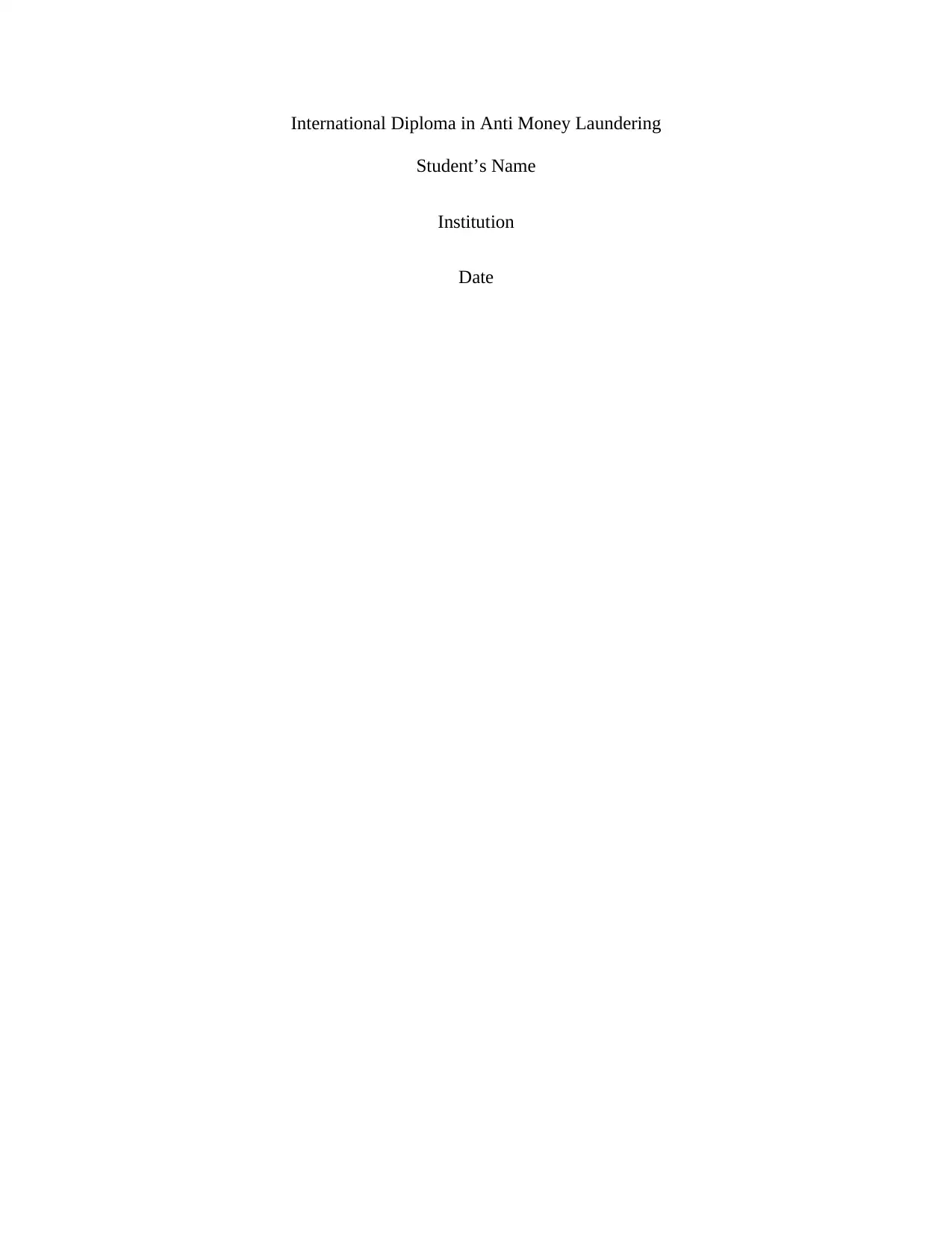
International Diploma in Anti Money Laundering
Student’s Name
Institution
Date
Student’s Name
Institution
Date
Paraphrase This Document
Need a fresh take? Get an instant paraphrase of this document with our AI Paraphraser
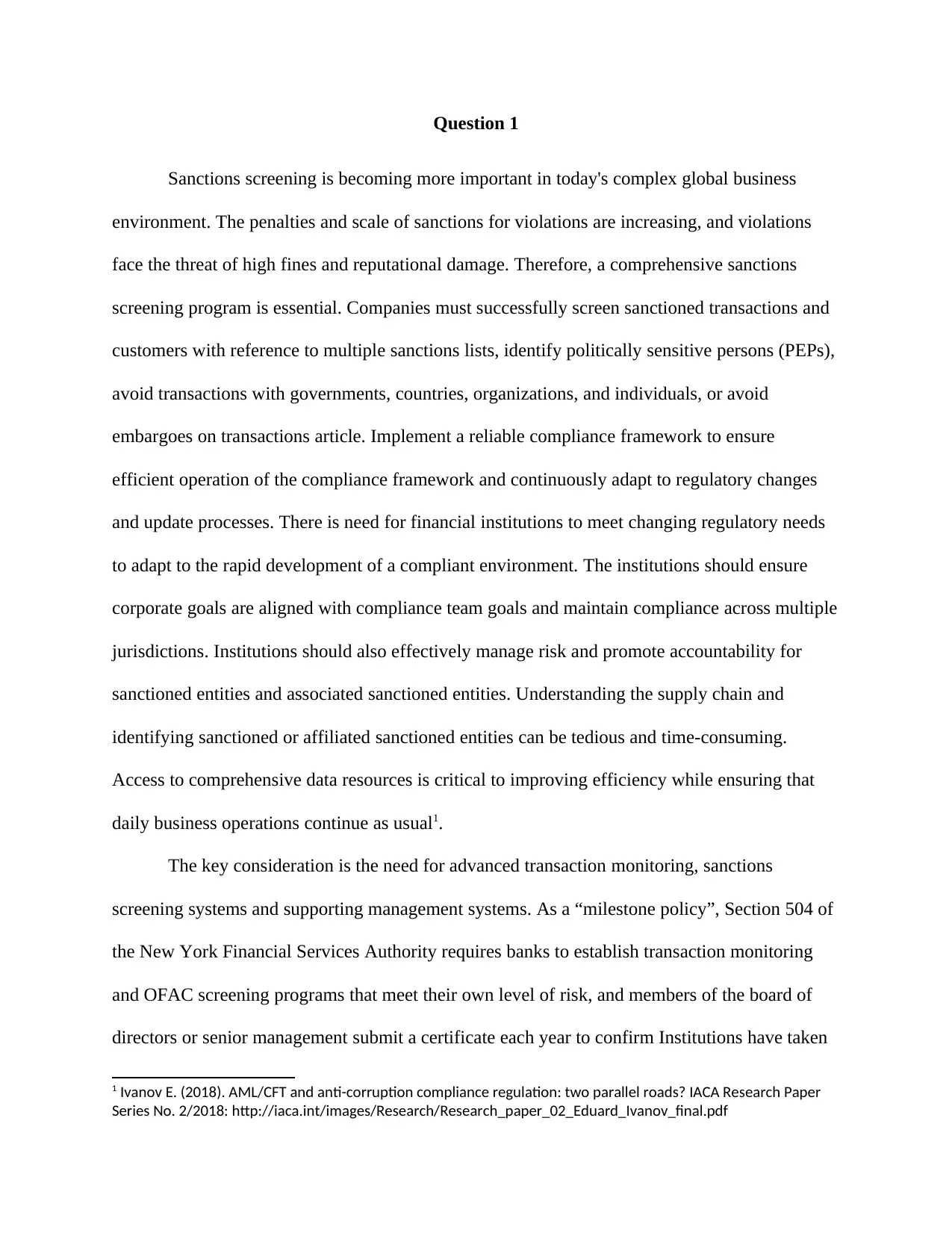
Question 1
Sanctions screening is becoming more important in today's complex global business
environment. The penalties and scale of sanctions for violations are increasing, and violations
face the threat of high fines and reputational damage. Therefore, a comprehensive sanctions
screening program is essential. Companies must successfully screen sanctioned transactions and
customers with reference to multiple sanctions lists, identify politically sensitive persons (PEPs),
avoid transactions with governments, countries, organizations, and individuals, or avoid
embargoes on transactions article. Implement a reliable compliance framework to ensure
efficient operation of the compliance framework and continuously adapt to regulatory changes
and update processes. There is need for financial institutions to meet changing regulatory needs
to adapt to the rapid development of a compliant environment. The institutions should ensure
corporate goals are aligned with compliance team goals and maintain compliance across multiple
jurisdictions. Institutions should also effectively manage risk and promote accountability for
sanctioned entities and associated sanctioned entities. Understanding the supply chain and
identifying sanctioned or affiliated sanctioned entities can be tedious and time-consuming.
Access to comprehensive data resources is critical to improving efficiency while ensuring that
daily business operations continue as usual1.
The key consideration is the need for advanced transaction monitoring, sanctions
screening systems and supporting management systems. As a “milestone policy”, Section 504 of
the New York Financial Services Authority requires banks to establish transaction monitoring
and OFAC screening programs that meet their own level of risk, and members of the board of
directors or senior management submit a certificate each year to confirm Institutions have taken
1 Ivanov E. (2018). AML/CFT and anti-corruption compliance regulation: two parallel roads? IACA Research Paper
Series No. 2/2018: http://iaca.int/images/Research/Research_paper_02_Eduard_Ivanov_final.pdf
Sanctions screening is becoming more important in today's complex global business
environment. The penalties and scale of sanctions for violations are increasing, and violations
face the threat of high fines and reputational damage. Therefore, a comprehensive sanctions
screening program is essential. Companies must successfully screen sanctioned transactions and
customers with reference to multiple sanctions lists, identify politically sensitive persons (PEPs),
avoid transactions with governments, countries, organizations, and individuals, or avoid
embargoes on transactions article. Implement a reliable compliance framework to ensure
efficient operation of the compliance framework and continuously adapt to regulatory changes
and update processes. There is need for financial institutions to meet changing regulatory needs
to adapt to the rapid development of a compliant environment. The institutions should ensure
corporate goals are aligned with compliance team goals and maintain compliance across multiple
jurisdictions. Institutions should also effectively manage risk and promote accountability for
sanctioned entities and associated sanctioned entities. Understanding the supply chain and
identifying sanctioned or affiliated sanctioned entities can be tedious and time-consuming.
Access to comprehensive data resources is critical to improving efficiency while ensuring that
daily business operations continue as usual1.
The key consideration is the need for advanced transaction monitoring, sanctions
screening systems and supporting management systems. As a “milestone policy”, Section 504 of
the New York Financial Services Authority requires banks to establish transaction monitoring
and OFAC screening programs that meet their own level of risk, and members of the board of
directors or senior management submit a certificate each year to confirm Institutions have taken
1 Ivanov E. (2018). AML/CFT and anti-corruption compliance regulation: two parallel roads? IACA Research Paper
Series No. 2/2018: http://iaca.int/images/Research/Research_paper_02_Eduard_Ivanov_final.pdf
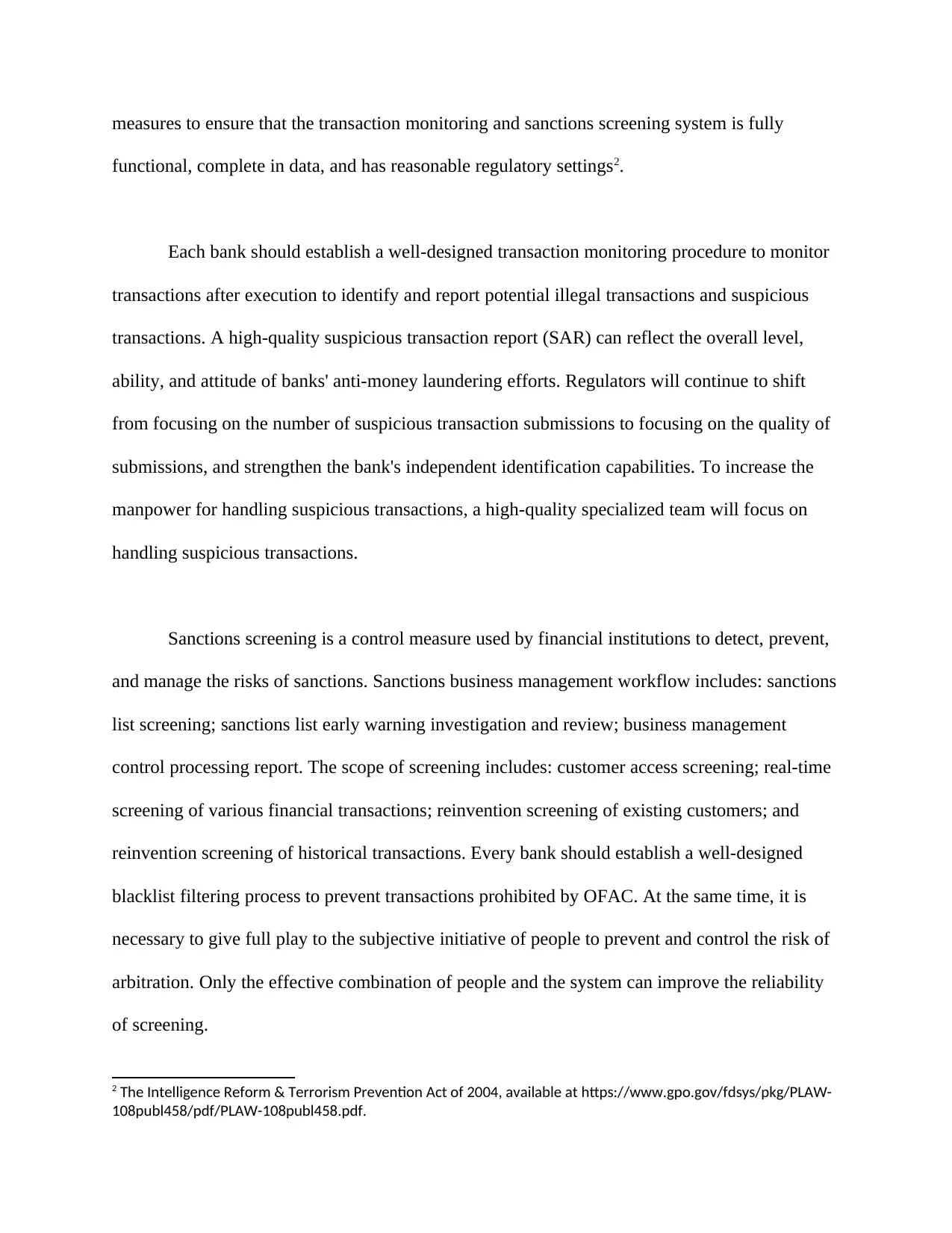
measures to ensure that the transaction monitoring and sanctions screening system is fully
functional, complete in data, and has reasonable regulatory settings2.
Each bank should establish a well-designed transaction monitoring procedure to monitor
transactions after execution to identify and report potential illegal transactions and suspicious
transactions. A high-quality suspicious transaction report (SAR) can reflect the overall level,
ability, and attitude of banks' anti-money laundering efforts. Regulators will continue to shift
from focusing on the number of suspicious transaction submissions to focusing on the quality of
submissions, and strengthen the bank's independent identification capabilities. To increase the
manpower for handling suspicious transactions, a high-quality specialized team will focus on
handling suspicious transactions.
Sanctions screening is a control measure used by financial institutions to detect, prevent,
and manage the risks of sanctions. Sanctions business management workflow includes: sanctions
list screening; sanctions list early warning investigation and review; business management
control processing report. The scope of screening includes: customer access screening; real-time
screening of various financial transactions; reinvention screening of existing customers; and
reinvention screening of historical transactions. Every bank should establish a well-designed
blacklist filtering process to prevent transactions prohibited by OFAC. At the same time, it is
necessary to give full play to the subjective initiative of people to prevent and control the risk of
arbitration. Only the effective combination of people and the system can improve the reliability
of screening.
2 The Intelligence Reform & Terrorism Prevention Act of 2004, available at https://www.gpo.gov/fdsys/pkg/PLAW-
108publ458/pdf/PLAW-108publ458.pdf.
functional, complete in data, and has reasonable regulatory settings2.
Each bank should establish a well-designed transaction monitoring procedure to monitor
transactions after execution to identify and report potential illegal transactions and suspicious
transactions. A high-quality suspicious transaction report (SAR) can reflect the overall level,
ability, and attitude of banks' anti-money laundering efforts. Regulators will continue to shift
from focusing on the number of suspicious transaction submissions to focusing on the quality of
submissions, and strengthen the bank's independent identification capabilities. To increase the
manpower for handling suspicious transactions, a high-quality specialized team will focus on
handling suspicious transactions.
Sanctions screening is a control measure used by financial institutions to detect, prevent,
and manage the risks of sanctions. Sanctions business management workflow includes: sanctions
list screening; sanctions list early warning investigation and review; business management
control processing report. The scope of screening includes: customer access screening; real-time
screening of various financial transactions; reinvention screening of existing customers; and
reinvention screening of historical transactions. Every bank should establish a well-designed
blacklist filtering process to prevent transactions prohibited by OFAC. At the same time, it is
necessary to give full play to the subjective initiative of people to prevent and control the risk of
arbitration. Only the effective combination of people and the system can improve the reliability
of screening.
2 The Intelligence Reform & Terrorism Prevention Act of 2004, available at https://www.gpo.gov/fdsys/pkg/PLAW-
108publ458/pdf/PLAW-108publ458.pdf.
⊘ This is a preview!⊘
Do you want full access?
Subscribe today to unlock all pages.

Trusted by 1+ million students worldwide
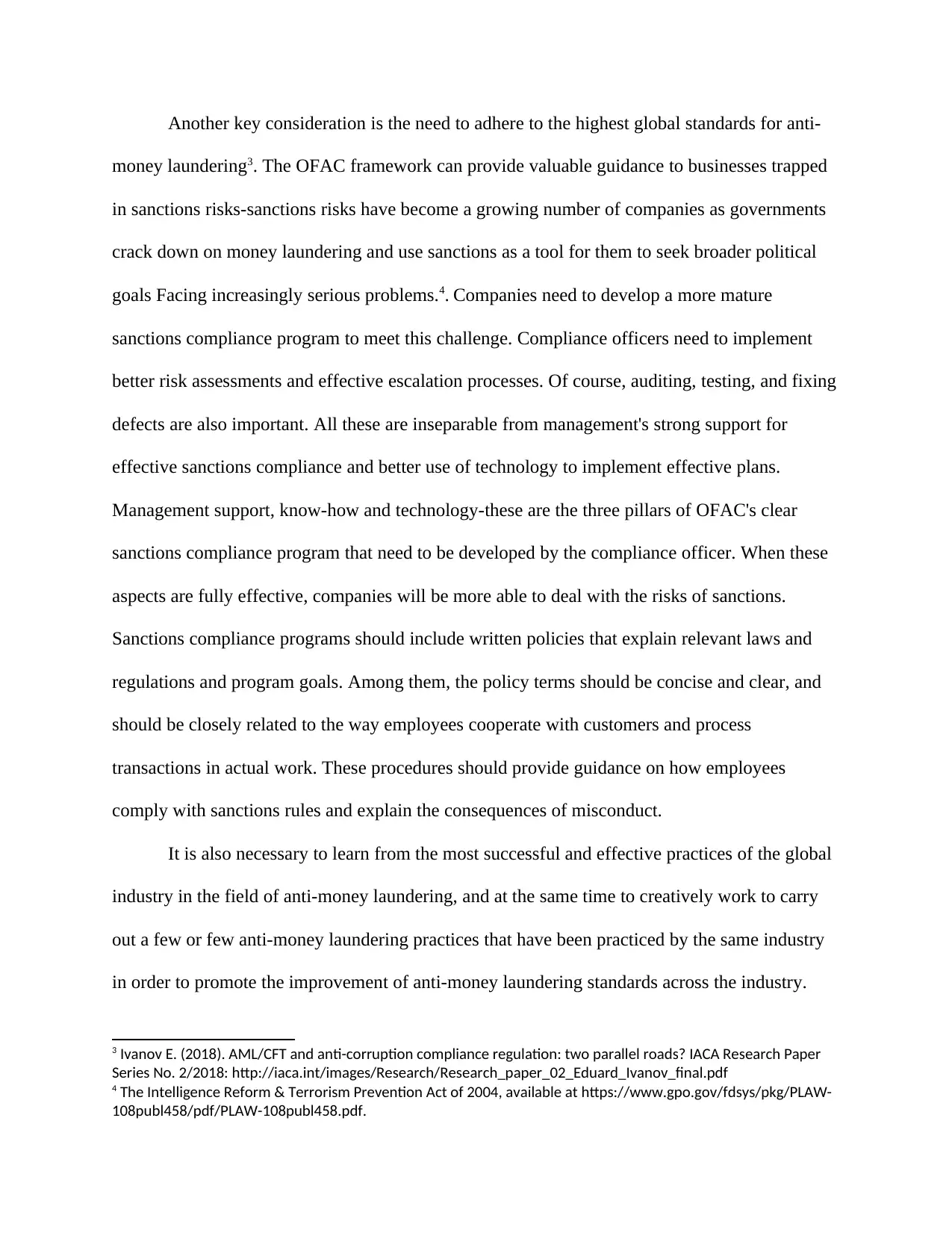
Another key consideration is the need to adhere to the highest global standards for anti-
money laundering3. The OFAC framework can provide valuable guidance to businesses trapped
in sanctions risks-sanctions risks have become a growing number of companies as governments
crack down on money laundering and use sanctions as a tool for them to seek broader political
goals Facing increasingly serious problems.4. Companies need to develop a more mature
sanctions compliance program to meet this challenge. Compliance officers need to implement
better risk assessments and effective escalation processes. Of course, auditing, testing, and fixing
defects are also important. All these are inseparable from management's strong support for
effective sanctions compliance and better use of technology to implement effective plans.
Management support, know-how and technology-these are the three pillars of OFAC's clear
sanctions compliance program that need to be developed by the compliance officer. When these
aspects are fully effective, companies will be more able to deal with the risks of sanctions.
Sanctions compliance programs should include written policies that explain relevant laws and
regulations and program goals. Among them, the policy terms should be concise and clear, and
should be closely related to the way employees cooperate with customers and process
transactions in actual work. These procedures should provide guidance on how employees
comply with sanctions rules and explain the consequences of misconduct.
It is also necessary to learn from the most successful and effective practices of the global
industry in the field of anti-money laundering, and at the same time to creatively work to carry
out a few or few anti-money laundering practices that have been practiced by the same industry
in order to promote the improvement of anti-money laundering standards across the industry.
3 Ivanov E. (2018). AML/CFT and anti-corruption compliance regulation: two parallel roads? IACA Research Paper
Series No. 2/2018: http://iaca.int/images/Research/Research_paper_02_Eduard_Ivanov_final.pdf
4 The Intelligence Reform & Terrorism Prevention Act of 2004, available at https://www.gpo.gov/fdsys/pkg/PLAW-
108publ458/pdf/PLAW-108publ458.pdf.
money laundering3. The OFAC framework can provide valuable guidance to businesses trapped
in sanctions risks-sanctions risks have become a growing number of companies as governments
crack down on money laundering and use sanctions as a tool for them to seek broader political
goals Facing increasingly serious problems.4. Companies need to develop a more mature
sanctions compliance program to meet this challenge. Compliance officers need to implement
better risk assessments and effective escalation processes. Of course, auditing, testing, and fixing
defects are also important. All these are inseparable from management's strong support for
effective sanctions compliance and better use of technology to implement effective plans.
Management support, know-how and technology-these are the three pillars of OFAC's clear
sanctions compliance program that need to be developed by the compliance officer. When these
aspects are fully effective, companies will be more able to deal with the risks of sanctions.
Sanctions compliance programs should include written policies that explain relevant laws and
regulations and program goals. Among them, the policy terms should be concise and clear, and
should be closely related to the way employees cooperate with customers and process
transactions in actual work. These procedures should provide guidance on how employees
comply with sanctions rules and explain the consequences of misconduct.
It is also necessary to learn from the most successful and effective practices of the global
industry in the field of anti-money laundering, and at the same time to creatively work to carry
out a few or few anti-money laundering practices that have been practiced by the same industry
in order to promote the improvement of anti-money laundering standards across the industry.
3 Ivanov E. (2018). AML/CFT and anti-corruption compliance regulation: two parallel roads? IACA Research Paper
Series No. 2/2018: http://iaca.int/images/Research/Research_paper_02_Eduard_Ivanov_final.pdf
4 The Intelligence Reform & Terrorism Prevention Act of 2004, available at https://www.gpo.gov/fdsys/pkg/PLAW-
108publ458/pdf/PLAW-108publ458.pdf.
Paraphrase This Document
Need a fresh take? Get an instant paraphrase of this document with our AI Paraphraser
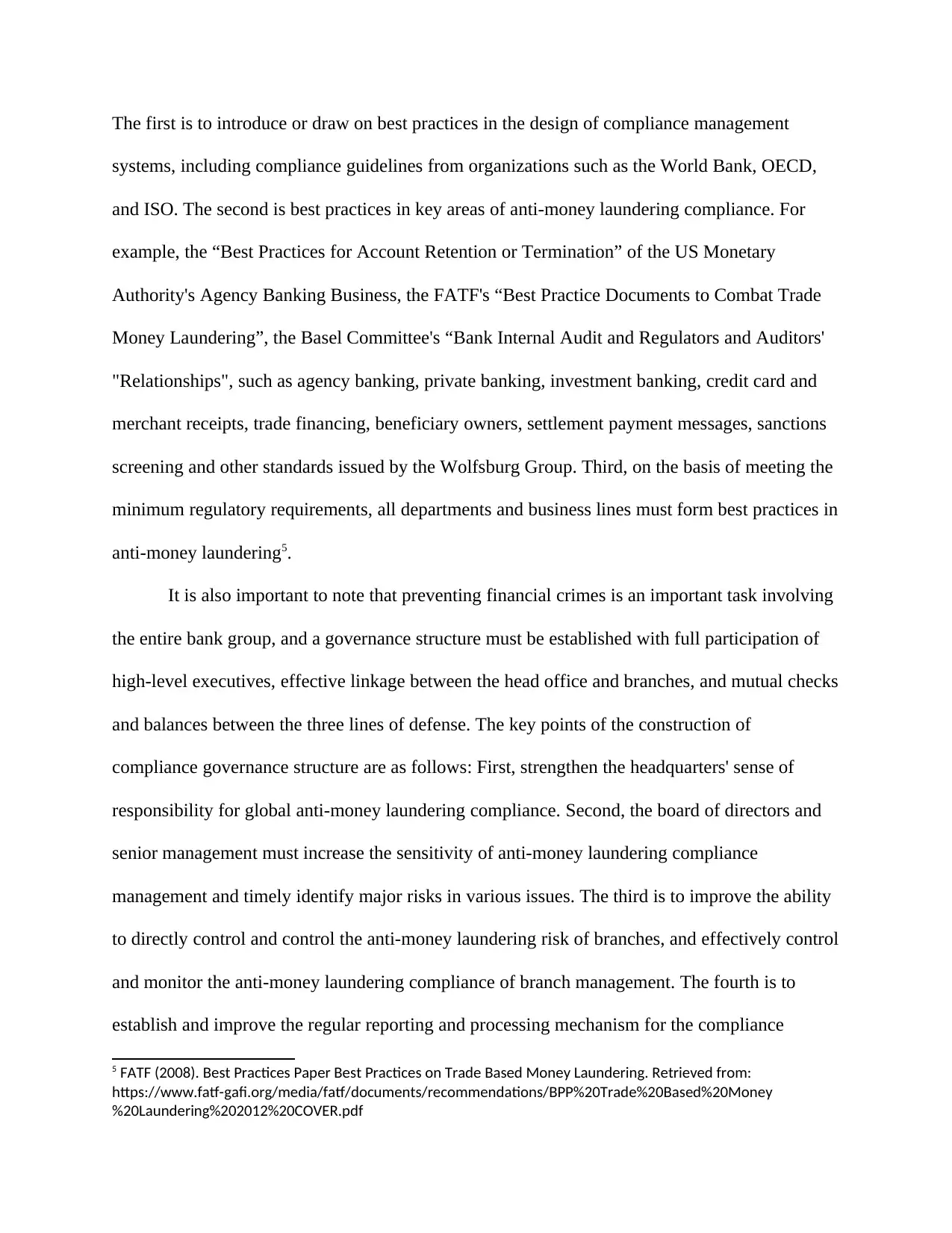
The first is to introduce or draw on best practices in the design of compliance management
systems, including compliance guidelines from organizations such as the World Bank, OECD,
and ISO. The second is best practices in key areas of anti-money laundering compliance. For
example, the “Best Practices for Account Retention or Termination” of the US Monetary
Authority's Agency Banking Business, the FATF's “Best Practice Documents to Combat Trade
Money Laundering”, the Basel Committee's “Bank Internal Audit and Regulators and Auditors'
"Relationships", such as agency banking, private banking, investment banking, credit card and
merchant receipts, trade financing, beneficiary owners, settlement payment messages, sanctions
screening and other standards issued by the Wolfsburg Group. Third, on the basis of meeting the
minimum regulatory requirements, all departments and business lines must form best practices in
anti-money laundering5.
It is also important to note that preventing financial crimes is an important task involving
the entire bank group, and a governance structure must be established with full participation of
high-level executives, effective linkage between the head office and branches, and mutual checks
and balances between the three lines of defense. The key points of the construction of
compliance governance structure are as follows: First, strengthen the headquarters' sense of
responsibility for global anti-money laundering compliance. Second, the board of directors and
senior management must increase the sensitivity of anti-money laundering compliance
management and timely identify major risks in various issues. The third is to improve the ability
to directly control and control the anti-money laundering risk of branches, and effectively control
and monitor the anti-money laundering compliance of branch management. The fourth is to
establish and improve the regular reporting and processing mechanism for the compliance
5 FATF (2008). Best Practices Paper Best Practices on Trade Based Money Laundering. Retrieved from:
https://www.fatf-gafi.org/media/fatf/documents/recommendations/BPP%20Trade%20Based%20Money
%20Laundering%202012%20COVER.pdf
systems, including compliance guidelines from organizations such as the World Bank, OECD,
and ISO. The second is best practices in key areas of anti-money laundering compliance. For
example, the “Best Practices for Account Retention or Termination” of the US Monetary
Authority's Agency Banking Business, the FATF's “Best Practice Documents to Combat Trade
Money Laundering”, the Basel Committee's “Bank Internal Audit and Regulators and Auditors'
"Relationships", such as agency banking, private banking, investment banking, credit card and
merchant receipts, trade financing, beneficiary owners, settlement payment messages, sanctions
screening and other standards issued by the Wolfsburg Group. Third, on the basis of meeting the
minimum regulatory requirements, all departments and business lines must form best practices in
anti-money laundering5.
It is also important to note that preventing financial crimes is an important task involving
the entire bank group, and a governance structure must be established with full participation of
high-level executives, effective linkage between the head office and branches, and mutual checks
and balances between the three lines of defense. The key points of the construction of
compliance governance structure are as follows: First, strengthen the headquarters' sense of
responsibility for global anti-money laundering compliance. Second, the board of directors and
senior management must increase the sensitivity of anti-money laundering compliance
management and timely identify major risks in various issues. The third is to improve the ability
to directly control and control the anti-money laundering risk of branches, and effectively control
and monitor the anti-money laundering compliance of branch management. The fourth is to
establish and improve the regular reporting and processing mechanism for the compliance
5 FATF (2008). Best Practices Paper Best Practices on Trade Based Money Laundering. Retrieved from:
https://www.fatf-gafi.org/media/fatf/documents/recommendations/BPP%20Trade%20Based%20Money
%20Laundering%202012%20COVER.pdf
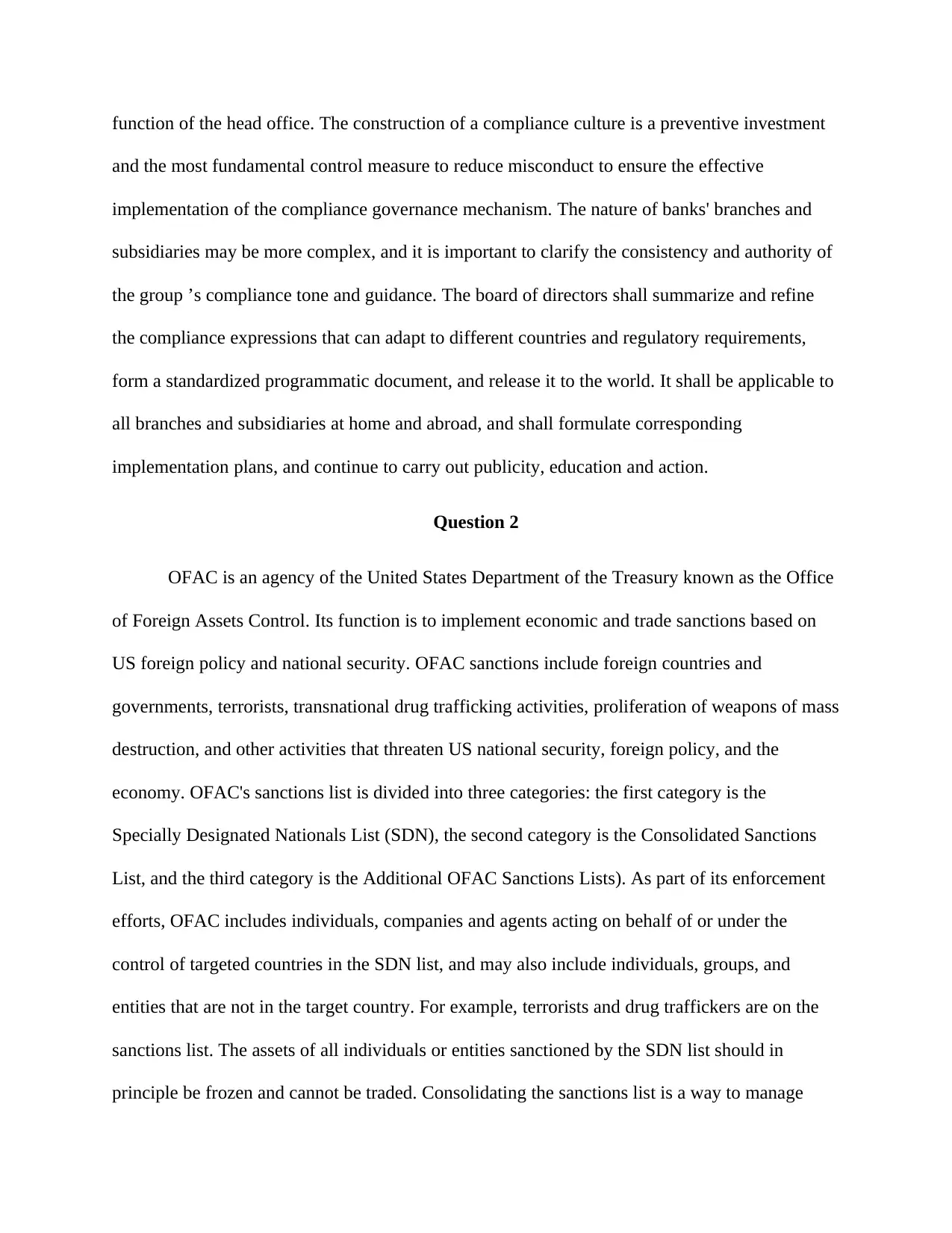
function of the head office. The construction of a compliance culture is a preventive investment
and the most fundamental control measure to reduce misconduct to ensure the effective
implementation of the compliance governance mechanism. The nature of banks' branches and
subsidiaries may be more complex, and it is important to clarify the consistency and authority of
the group ’s compliance tone and guidance. The board of directors shall summarize and refine
the compliance expressions that can adapt to different countries and regulatory requirements,
form a standardized programmatic document, and release it to the world. It shall be applicable to
all branches and subsidiaries at home and abroad, and shall formulate corresponding
implementation plans, and continue to carry out publicity, education and action.
Question 2
OFAC is an agency of the United States Department of the Treasury known as the Office
of Foreign Assets Control. Its function is to implement economic and trade sanctions based on
US foreign policy and national security. OFAC sanctions include foreign countries and
governments, terrorists, transnational drug trafficking activities, proliferation of weapons of mass
destruction, and other activities that threaten US national security, foreign policy, and the
economy. OFAC's sanctions list is divided into three categories: the first category is the
Specially Designated Nationals List (SDN), the second category is the Consolidated Sanctions
List, and the third category is the Additional OFAC Sanctions Lists). As part of its enforcement
efforts, OFAC includes individuals, companies and agents acting on behalf of or under the
control of targeted countries in the SDN list, and may also include individuals, groups, and
entities that are not in the target country. For example, terrorists and drug traffickers are on the
sanctions list. The assets of all individuals or entities sanctioned by the SDN list should in
principle be frozen and cannot be traded. Consolidating the sanctions list is a way to manage
and the most fundamental control measure to reduce misconduct to ensure the effective
implementation of the compliance governance mechanism. The nature of banks' branches and
subsidiaries may be more complex, and it is important to clarify the consistency and authority of
the group ’s compliance tone and guidance. The board of directors shall summarize and refine
the compliance expressions that can adapt to different countries and regulatory requirements,
form a standardized programmatic document, and release it to the world. It shall be applicable to
all branches and subsidiaries at home and abroad, and shall formulate corresponding
implementation plans, and continue to carry out publicity, education and action.
Question 2
OFAC is an agency of the United States Department of the Treasury known as the Office
of Foreign Assets Control. Its function is to implement economic and trade sanctions based on
US foreign policy and national security. OFAC sanctions include foreign countries and
governments, terrorists, transnational drug trafficking activities, proliferation of weapons of mass
destruction, and other activities that threaten US national security, foreign policy, and the
economy. OFAC's sanctions list is divided into three categories: the first category is the
Specially Designated Nationals List (SDN), the second category is the Consolidated Sanctions
List, and the third category is the Additional OFAC Sanctions Lists). As part of its enforcement
efforts, OFAC includes individuals, companies and agents acting on behalf of or under the
control of targeted countries in the SDN list, and may also include individuals, groups, and
entities that are not in the target country. For example, terrorists and drug traffickers are on the
sanctions list. The assets of all individuals or entities sanctioned by the SDN list should in
principle be frozen and cannot be traded. Consolidating the sanctions list is a way to manage
⊘ This is a preview!⊘
Do you want full access?
Subscribe today to unlock all pages.

Trusted by 1+ million students worldwide
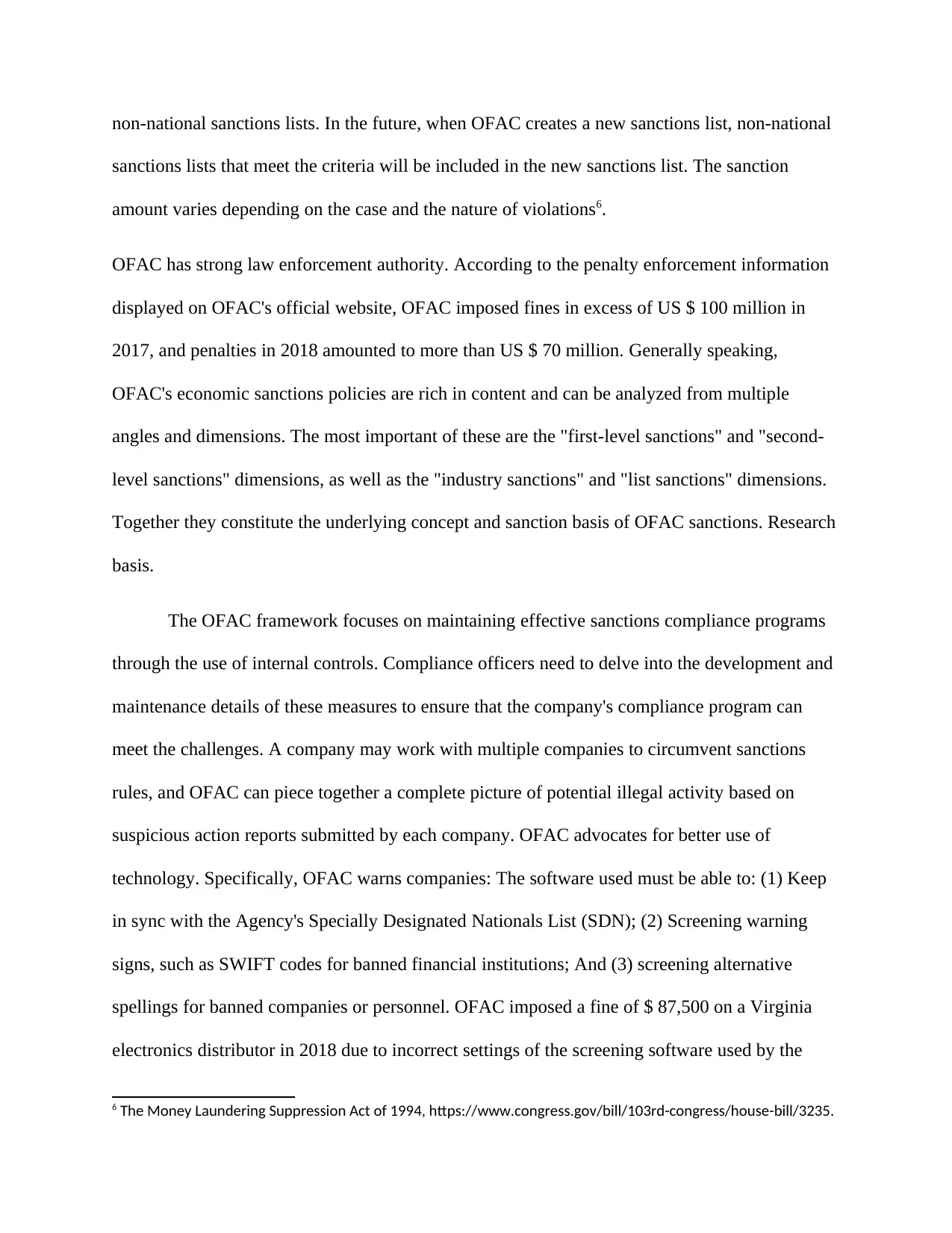
non-national sanctions lists. In the future, when OFAC creates a new sanctions list, non-national
sanctions lists that meet the criteria will be included in the new sanctions list. The sanction
amount varies depending on the case and the nature of violations6.
OFAC has strong law enforcement authority. According to the penalty enforcement information
displayed on OFAC's official website, OFAC imposed fines in excess of US $ 100 million in
2017, and penalties in 2018 amounted to more than US $ 70 million. Generally speaking,
OFAC's economic sanctions policies are rich in content and can be analyzed from multiple
angles and dimensions. The most important of these are the "first-level sanctions" and "second-
level sanctions" dimensions, as well as the "industry sanctions" and "list sanctions" dimensions.
Together they constitute the underlying concept and sanction basis of OFAC sanctions. Research
basis.
The OFAC framework focuses on maintaining effective sanctions compliance programs
through the use of internal controls. Compliance officers need to delve into the development and
maintenance details of these measures to ensure that the company's compliance program can
meet the challenges. A company may work with multiple companies to circumvent sanctions
rules, and OFAC can piece together a complete picture of potential illegal activity based on
suspicious action reports submitted by each company. OFAC advocates for better use of
technology. Specifically, OFAC warns companies: The software used must be able to: (1) Keep
in sync with the Agency's Specially Designated Nationals List (SDN); (2) Screening warning
signs, such as SWIFT codes for banned financial institutions; And (3) screening alternative
spellings for banned companies or personnel. OFAC imposed a fine of $ 87,500 on a Virginia
electronics distributor in 2018 due to incorrect settings of the screening software used by the
6 The Money Laundering Suppression Act of 1994, https://www.congress.gov/bill/103rd-congress/house-bill/3235.
sanctions lists that meet the criteria will be included in the new sanctions list. The sanction
amount varies depending on the case and the nature of violations6.
OFAC has strong law enforcement authority. According to the penalty enforcement information
displayed on OFAC's official website, OFAC imposed fines in excess of US $ 100 million in
2017, and penalties in 2018 amounted to more than US $ 70 million. Generally speaking,
OFAC's economic sanctions policies are rich in content and can be analyzed from multiple
angles and dimensions. The most important of these are the "first-level sanctions" and "second-
level sanctions" dimensions, as well as the "industry sanctions" and "list sanctions" dimensions.
Together they constitute the underlying concept and sanction basis of OFAC sanctions. Research
basis.
The OFAC framework focuses on maintaining effective sanctions compliance programs
through the use of internal controls. Compliance officers need to delve into the development and
maintenance details of these measures to ensure that the company's compliance program can
meet the challenges. A company may work with multiple companies to circumvent sanctions
rules, and OFAC can piece together a complete picture of potential illegal activity based on
suspicious action reports submitted by each company. OFAC advocates for better use of
technology. Specifically, OFAC warns companies: The software used must be able to: (1) Keep
in sync with the Agency's Specially Designated Nationals List (SDN); (2) Screening warning
signs, such as SWIFT codes for banned financial institutions; And (3) screening alternative
spellings for banned companies or personnel. OFAC imposed a fine of $ 87,500 on a Virginia
electronics distributor in 2018 due to incorrect settings of the screening software used by the
6 The Money Laundering Suppression Act of 1994, https://www.congress.gov/bill/103rd-congress/house-bill/3235.
Paraphrase This Document
Need a fresh take? Get an instant paraphrase of this document with our AI Paraphraser
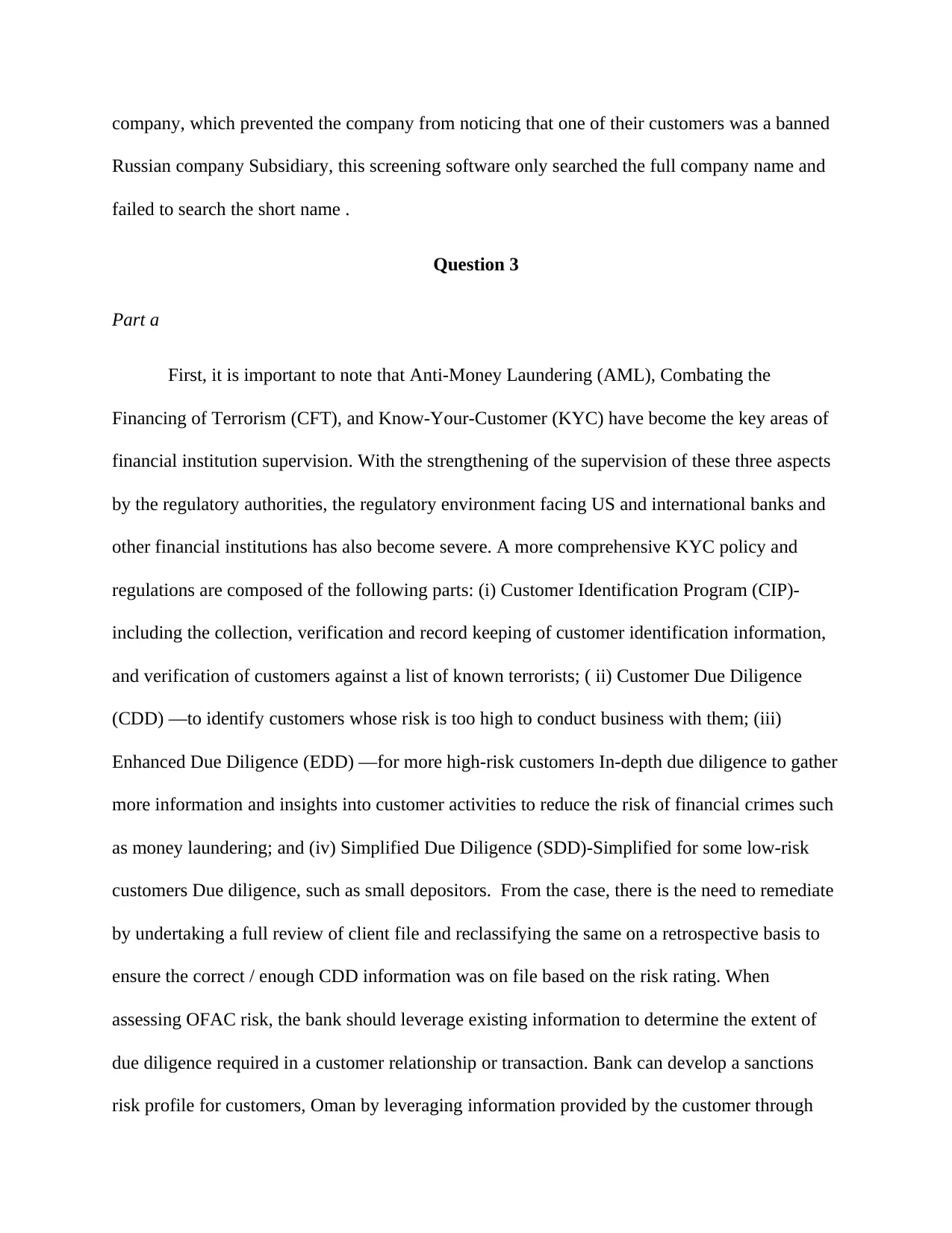
company, which prevented the company from noticing that one of their customers was a banned
Russian company Subsidiary, this screening software only searched the full company name and
failed to search the short name .
Question 3
Part a
First, it is important to note that Anti-Money Laundering (AML), Combating the
Financing of Terrorism (CFT), and Know-Your-Customer (KYC) have become the key areas of
financial institution supervision. With the strengthening of the supervision of these three aspects
by the regulatory authorities, the regulatory environment facing US and international banks and
other financial institutions has also become severe. A more comprehensive KYC policy and
regulations are composed of the following parts: (i) Customer Identification Program (CIP)-
including the collection, verification and record keeping of customer identification information,
and verification of customers against a list of known terrorists; ( ii) Customer Due Diligence
(CDD) —to identify customers whose risk is too high to conduct business with them; (iii)
Enhanced Due Diligence (EDD) —for more high-risk customers In-depth due diligence to gather
more information and insights into customer activities to reduce the risk of financial crimes such
as money laundering; and (iv) Simplified Due Diligence (SDD)-Simplified for some low-risk
customers Due diligence, such as small depositors. From the case, there is the need to remediate
by undertaking a full review of client file and reclassifying the same on a retrospective basis to
ensure the correct / enough CDD information was on file based on the risk rating. When
assessing OFAC risk, the bank should leverage existing information to determine the extent of
due diligence required in a customer relationship or transaction. Bank can develop a sanctions
risk profile for customers, Oman by leveraging information provided by the customer through
Russian company Subsidiary, this screening software only searched the full company name and
failed to search the short name .
Question 3
Part a
First, it is important to note that Anti-Money Laundering (AML), Combating the
Financing of Terrorism (CFT), and Know-Your-Customer (KYC) have become the key areas of
financial institution supervision. With the strengthening of the supervision of these three aspects
by the regulatory authorities, the regulatory environment facing US and international banks and
other financial institutions has also become severe. A more comprehensive KYC policy and
regulations are composed of the following parts: (i) Customer Identification Program (CIP)-
including the collection, verification and record keeping of customer identification information,
and verification of customers against a list of known terrorists; ( ii) Customer Due Diligence
(CDD) —to identify customers whose risk is too high to conduct business with them; (iii)
Enhanced Due Diligence (EDD) —for more high-risk customers In-depth due diligence to gather
more information and insights into customer activities to reduce the risk of financial crimes such
as money laundering; and (iv) Simplified Due Diligence (SDD)-Simplified for some low-risk
customers Due diligence, such as small depositors. From the case, there is the need to remediate
by undertaking a full review of client file and reclassifying the same on a retrospective basis to
ensure the correct / enough CDD information was on file based on the risk rating. When
assessing OFAC risk, the bank should leverage existing information to determine the extent of
due diligence required in a customer relationship or transaction. Bank can develop a sanctions
risk profile for customers, Oman by leveraging information provided by the customer through
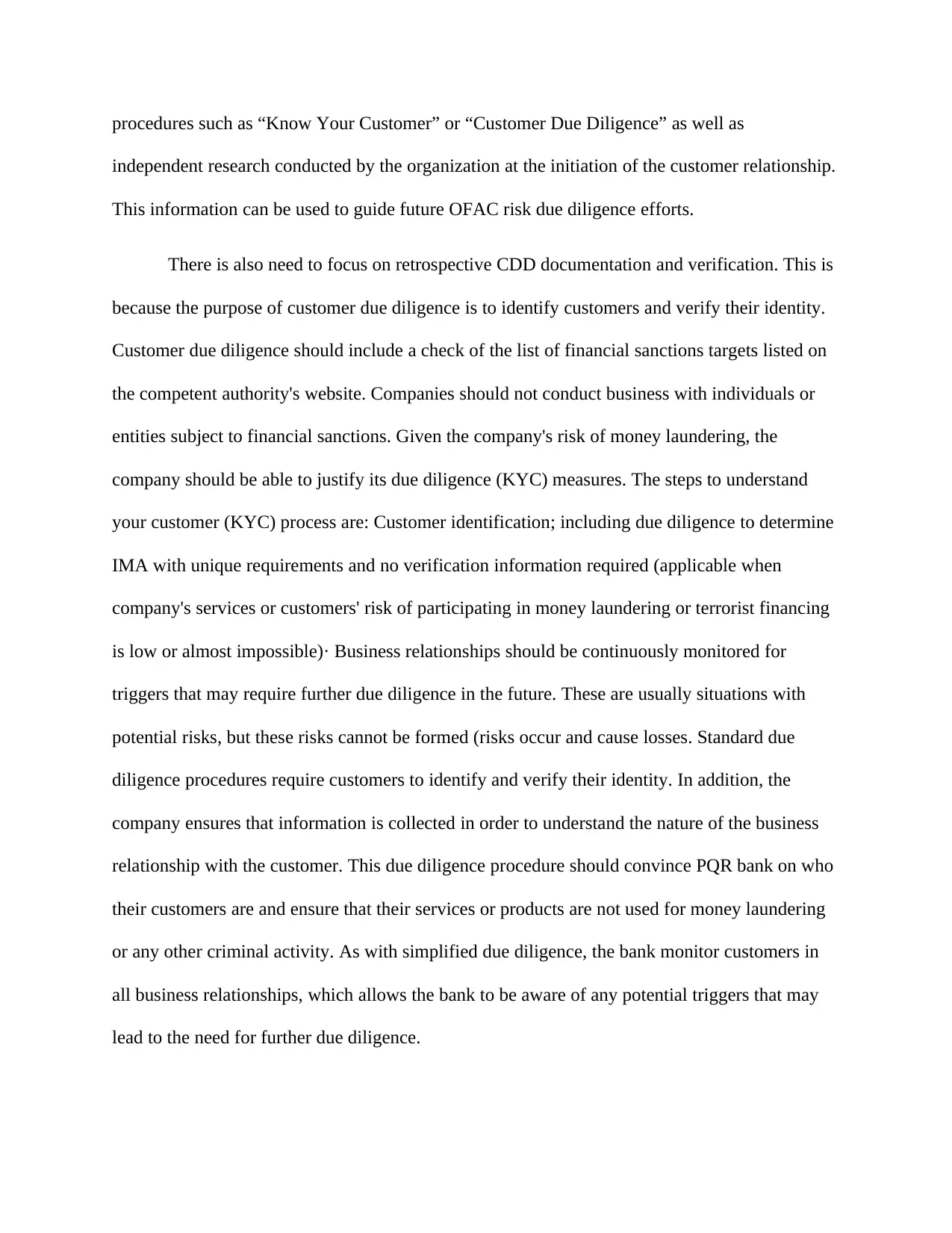
procedures such as “Know Your Customer” or “Customer Due Diligence” as well as
independent research conducted by the organization at the initiation of the customer relationship.
This information can be used to guide future OFAC risk due diligence efforts.
There is also need to focus on retrospective CDD documentation and verification. This is
because the purpose of customer due diligence is to identify customers and verify their identity.
Customer due diligence should include a check of the list of financial sanctions targets listed on
the competent authority's website. Companies should not conduct business with individuals or
entities subject to financial sanctions. Given the company's risk of money laundering, the
company should be able to justify its due diligence (KYC) measures. The steps to understand
your customer (KYC) process are: Customer identification; including due diligence to determine
IMA with unique requirements and no verification information required (applicable when
company's services or customers' risk of participating in money laundering or terrorist financing
is low or almost impossible)· Business relationships should be continuously monitored for
triggers that may require further due diligence in the future. These are usually situations with
potential risks, but these risks cannot be formed (risks occur and cause losses. Standard due
diligence procedures require customers to identify and verify their identity. In addition, the
company ensures that information is collected in order to understand the nature of the business
relationship with the customer. This due diligence procedure should convince PQR bank on who
their customers are and ensure that their services or products are not used for money laundering
or any other criminal activity. As with simplified due diligence, the bank monitor customers in
all business relationships, which allows the bank to be aware of any potential triggers that may
lead to the need for further due diligence.
independent research conducted by the organization at the initiation of the customer relationship.
This information can be used to guide future OFAC risk due diligence efforts.
There is also need to focus on retrospective CDD documentation and verification. This is
because the purpose of customer due diligence is to identify customers and verify their identity.
Customer due diligence should include a check of the list of financial sanctions targets listed on
the competent authority's website. Companies should not conduct business with individuals or
entities subject to financial sanctions. Given the company's risk of money laundering, the
company should be able to justify its due diligence (KYC) measures. The steps to understand
your customer (KYC) process are: Customer identification; including due diligence to determine
IMA with unique requirements and no verification information required (applicable when
company's services or customers' risk of participating in money laundering or terrorist financing
is low or almost impossible)· Business relationships should be continuously monitored for
triggers that may require further due diligence in the future. These are usually situations with
potential risks, but these risks cannot be formed (risks occur and cause losses. Standard due
diligence procedures require customers to identify and verify their identity. In addition, the
company ensures that information is collected in order to understand the nature of the business
relationship with the customer. This due diligence procedure should convince PQR bank on who
their customers are and ensure that their services or products are not used for money laundering
or any other criminal activity. As with simplified due diligence, the bank monitor customers in
all business relationships, which allows the bank to be aware of any potential triggers that may
lead to the need for further due diligence.
⊘ This is a preview!⊘
Do you want full access?
Subscribe today to unlock all pages.

Trusted by 1+ million students worldwide
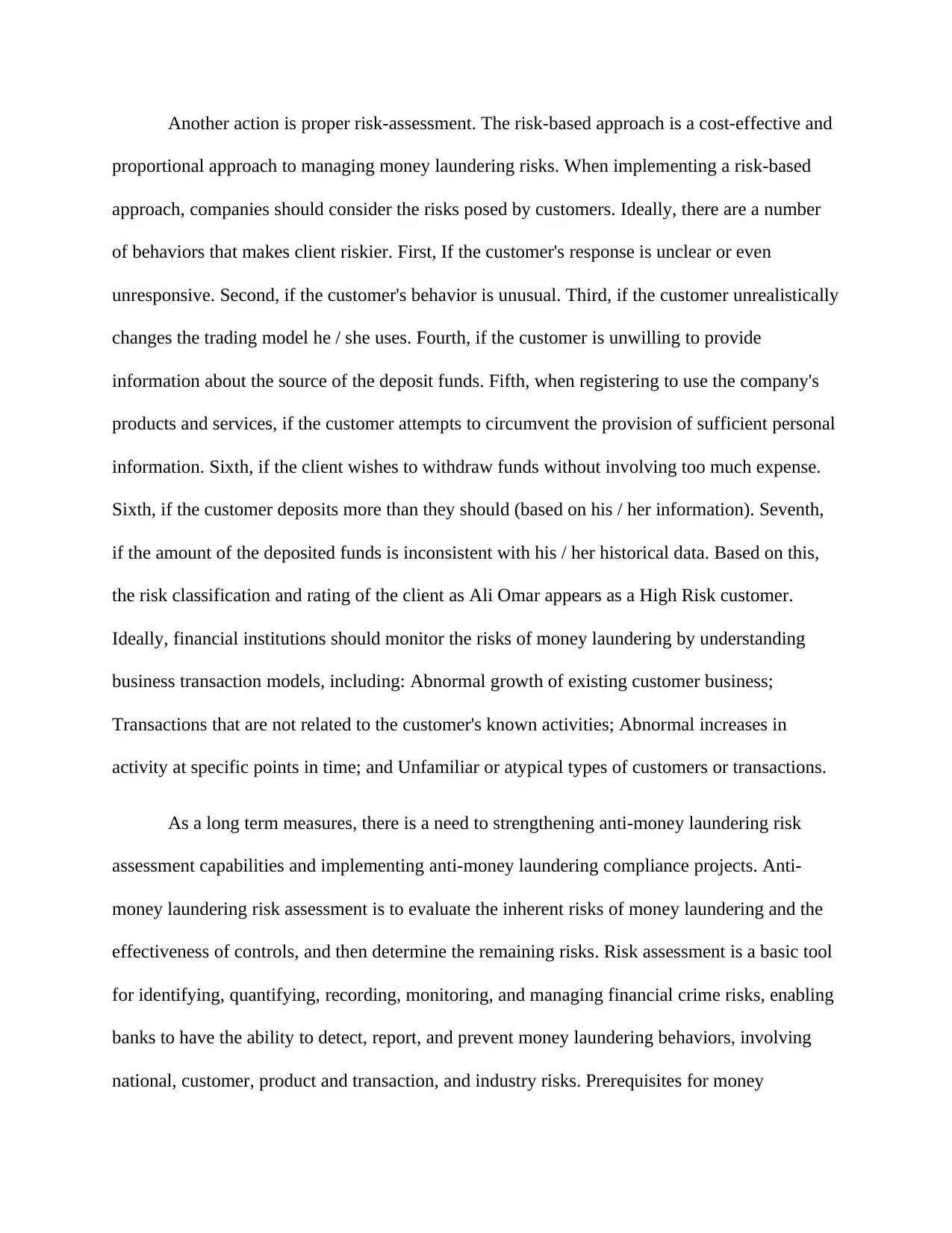
Another action is proper risk-assessment. The risk-based approach is a cost-effective and
proportional approach to managing money laundering risks. When implementing a risk-based
approach, companies should consider the risks posed by customers. Ideally, there are a number
of behaviors that makes client riskier. First, If the customer's response is unclear or even
unresponsive. Second, if the customer's behavior is unusual. Third, if the customer unrealistically
changes the trading model he / she uses. Fourth, if the customer is unwilling to provide
information about the source of the deposit funds. Fifth, when registering to use the company's
products and services, if the customer attempts to circumvent the provision of sufficient personal
information. Sixth, if the client wishes to withdraw funds without involving too much expense.
Sixth, if the customer deposits more than they should (based on his / her information). Seventh,
if the amount of the deposited funds is inconsistent with his / her historical data. Based on this,
the risk classification and rating of the client as Ali Omar appears as a High Risk customer.
Ideally, financial institutions should monitor the risks of money laundering by understanding
business transaction models, including: Abnormal growth of existing customer business;
Transactions that are not related to the customer's known activities; Abnormal increases in
activity at specific points in time; and Unfamiliar or atypical types of customers or transactions.
As a long term measures, there is a need to strengthening anti-money laundering risk
assessment capabilities and implementing anti-money laundering compliance projects. Anti-
money laundering risk assessment is to evaluate the inherent risks of money laundering and the
effectiveness of controls, and then determine the remaining risks. Risk assessment is a basic tool
for identifying, quantifying, recording, monitoring, and managing financial crime risks, enabling
banks to have the ability to detect, report, and prevent money laundering behaviors, involving
national, customer, product and transaction, and industry risks. Prerequisites for money
proportional approach to managing money laundering risks. When implementing a risk-based
approach, companies should consider the risks posed by customers. Ideally, there are a number
of behaviors that makes client riskier. First, If the customer's response is unclear or even
unresponsive. Second, if the customer's behavior is unusual. Third, if the customer unrealistically
changes the trading model he / she uses. Fourth, if the customer is unwilling to provide
information about the source of the deposit funds. Fifth, when registering to use the company's
products and services, if the customer attempts to circumvent the provision of sufficient personal
information. Sixth, if the client wishes to withdraw funds without involving too much expense.
Sixth, if the customer deposits more than they should (based on his / her information). Seventh,
if the amount of the deposited funds is inconsistent with his / her historical data. Based on this,
the risk classification and rating of the client as Ali Omar appears as a High Risk customer.
Ideally, financial institutions should monitor the risks of money laundering by understanding
business transaction models, including: Abnormal growth of existing customer business;
Transactions that are not related to the customer's known activities; Abnormal increases in
activity at specific points in time; and Unfamiliar or atypical types of customers or transactions.
As a long term measures, there is a need to strengthening anti-money laundering risk
assessment capabilities and implementing anti-money laundering compliance projects. Anti-
money laundering risk assessment is to evaluate the inherent risks of money laundering and the
effectiveness of controls, and then determine the remaining risks. Risk assessment is a basic tool
for identifying, quantifying, recording, monitoring, and managing financial crime risks, enabling
banks to have the ability to detect, report, and prevent money laundering behaviors, involving
national, customer, product and transaction, and industry risks. Prerequisites for money
Paraphrase This Document
Need a fresh take? Get an instant paraphrase of this document with our AI Paraphraser
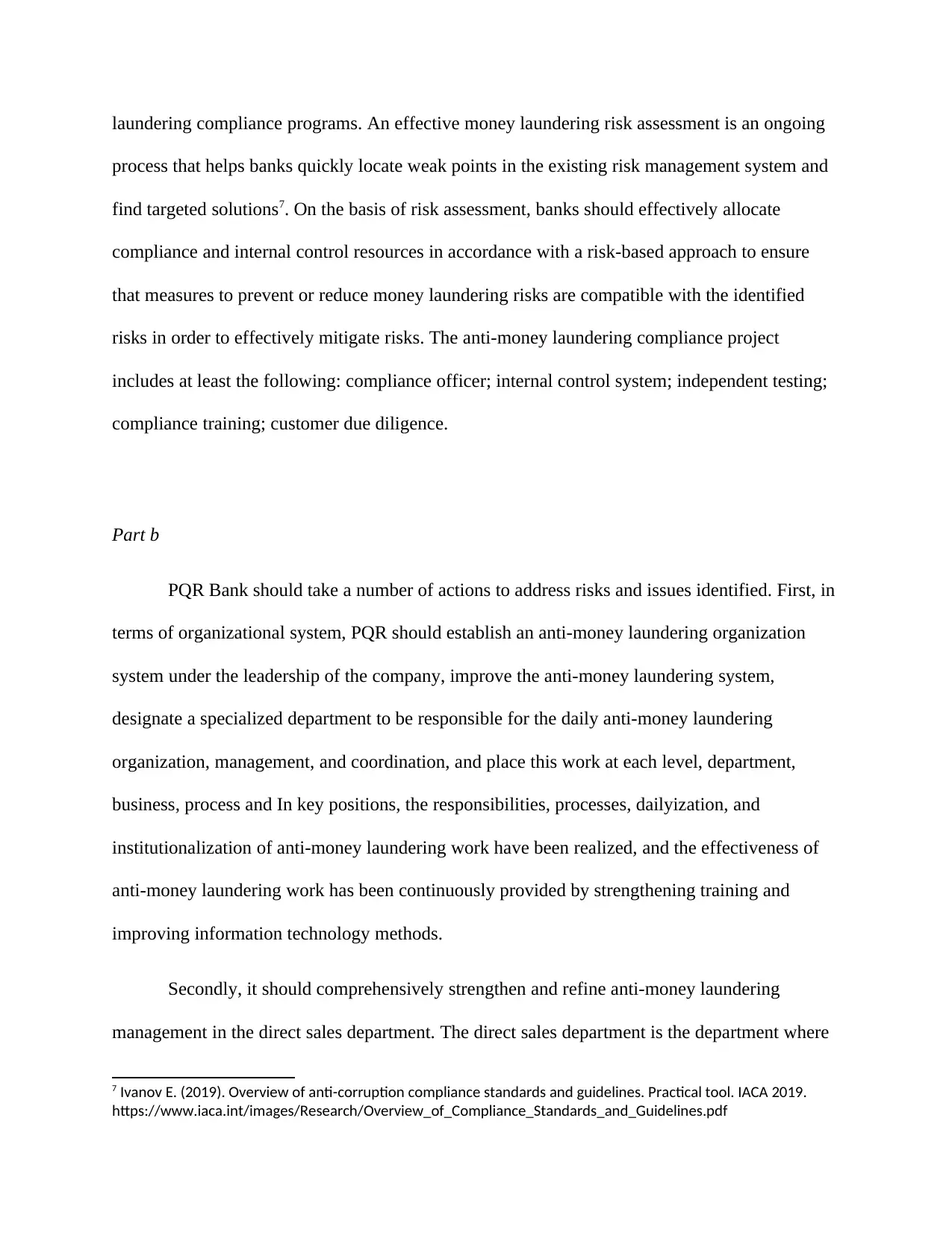
laundering compliance programs. An effective money laundering risk assessment is an ongoing
process that helps banks quickly locate weak points in the existing risk management system and
find targeted solutions7. On the basis of risk assessment, banks should effectively allocate
compliance and internal control resources in accordance with a risk-based approach to ensure
that measures to prevent or reduce money laundering risks are compatible with the identified
risks in order to effectively mitigate risks. The anti-money laundering compliance project
includes at least the following: compliance officer; internal control system; independent testing;
compliance training; customer due diligence.
Part b
PQR Bank should take a number of actions to address risks and issues identified. First, in
terms of organizational system, PQR should establish an anti-money laundering organization
system under the leadership of the company, improve the anti-money laundering system,
designate a specialized department to be responsible for the daily anti-money laundering
organization, management, and coordination, and place this work at each level, department,
business, process and In key positions, the responsibilities, processes, dailyization, and
institutionalization of anti-money laundering work have been realized, and the effectiveness of
anti-money laundering work has been continuously provided by strengthening training and
improving information technology methods.
Secondly, it should comprehensively strengthen and refine anti-money laundering
management in the direct sales department. The direct sales department is the department where
7 Ivanov E. (2019). Overview of anti-corruption compliance standards and guidelines. Practical tool. IACA 2019.
https://www.iaca.int/images/Research/Overview_of_Compliance_Standards_and_Guidelines.pdf
process that helps banks quickly locate weak points in the existing risk management system and
find targeted solutions7. On the basis of risk assessment, banks should effectively allocate
compliance and internal control resources in accordance with a risk-based approach to ensure
that measures to prevent or reduce money laundering risks are compatible with the identified
risks in order to effectively mitigate risks. The anti-money laundering compliance project
includes at least the following: compliance officer; internal control system; independent testing;
compliance training; customer due diligence.
Part b
PQR Bank should take a number of actions to address risks and issues identified. First, in
terms of organizational system, PQR should establish an anti-money laundering organization
system under the leadership of the company, improve the anti-money laundering system,
designate a specialized department to be responsible for the daily anti-money laundering
organization, management, and coordination, and place this work at each level, department,
business, process and In key positions, the responsibilities, processes, dailyization, and
institutionalization of anti-money laundering work have been realized, and the effectiveness of
anti-money laundering work has been continuously provided by strengthening training and
improving information technology methods.
Secondly, it should comprehensively strengthen and refine anti-money laundering
management in the direct sales department. The direct sales department is the department where
7 Ivanov E. (2019). Overview of anti-corruption compliance standards and guidelines. Practical tool. IACA 2019.
https://www.iaca.int/images/Research/Overview_of_Compliance_Standards_and_Guidelines.pdf
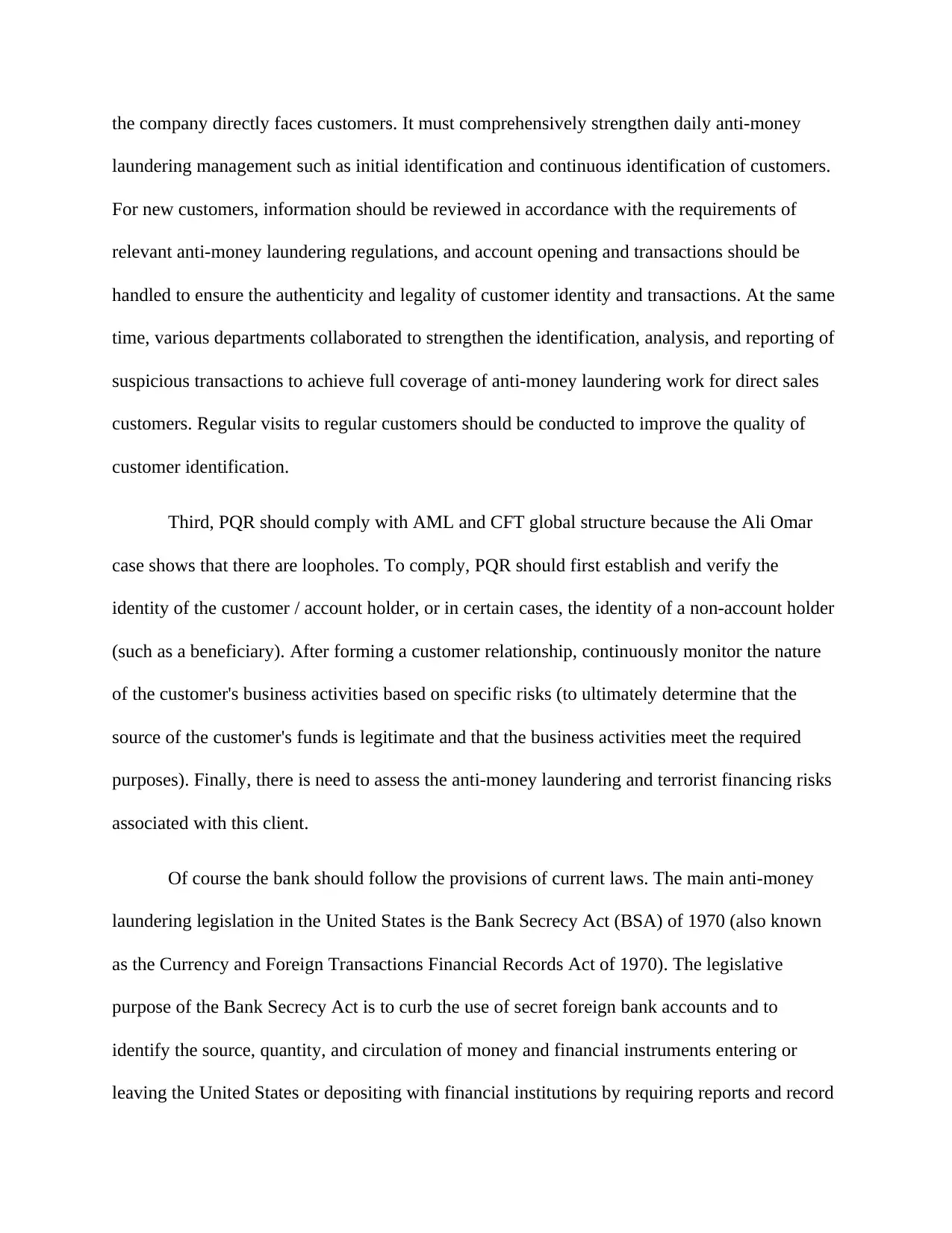
the company directly faces customers. It must comprehensively strengthen daily anti-money
laundering management such as initial identification and continuous identification of customers.
For new customers, information should be reviewed in accordance with the requirements of
relevant anti-money laundering regulations, and account opening and transactions should be
handled to ensure the authenticity and legality of customer identity and transactions. At the same
time, various departments collaborated to strengthen the identification, analysis, and reporting of
suspicious transactions to achieve full coverage of anti-money laundering work for direct sales
customers. Regular visits to regular customers should be conducted to improve the quality of
customer identification.
Third, PQR should comply with AML and CFT global structure because the Ali Omar
case shows that there are loopholes. To comply, PQR should first establish and verify the
identity of the customer / account holder, or in certain cases, the identity of a non-account holder
(such as a beneficiary). After forming a customer relationship, continuously monitor the nature
of the customer's business activities based on specific risks (to ultimately determine that the
source of the customer's funds is legitimate and that the business activities meet the required
purposes). Finally, there is need to assess the anti-money laundering and terrorist financing risks
associated with this client.
Of course the bank should follow the provisions of current laws. The main anti-money
laundering legislation in the United States is the Bank Secrecy Act (BSA) of 1970 (also known
as the Currency and Foreign Transactions Financial Records Act of 1970). The legislative
purpose of the Bank Secrecy Act is to curb the use of secret foreign bank accounts and to
identify the source, quantity, and circulation of money and financial instruments entering or
leaving the United States or depositing with financial institutions by requiring reports and record
laundering management such as initial identification and continuous identification of customers.
For new customers, information should be reviewed in accordance with the requirements of
relevant anti-money laundering regulations, and account opening and transactions should be
handled to ensure the authenticity and legality of customer identity and transactions. At the same
time, various departments collaborated to strengthen the identification, analysis, and reporting of
suspicious transactions to achieve full coverage of anti-money laundering work for direct sales
customers. Regular visits to regular customers should be conducted to improve the quality of
customer identification.
Third, PQR should comply with AML and CFT global structure because the Ali Omar
case shows that there are loopholes. To comply, PQR should first establish and verify the
identity of the customer / account holder, or in certain cases, the identity of a non-account holder
(such as a beneficiary). After forming a customer relationship, continuously monitor the nature
of the customer's business activities based on specific risks (to ultimately determine that the
source of the customer's funds is legitimate and that the business activities meet the required
purposes). Finally, there is need to assess the anti-money laundering and terrorist financing risks
associated with this client.
Of course the bank should follow the provisions of current laws. The main anti-money
laundering legislation in the United States is the Bank Secrecy Act (BSA) of 1970 (also known
as the Currency and Foreign Transactions Financial Records Act of 1970). The legislative
purpose of the Bank Secrecy Act is to curb the use of secret foreign bank accounts and to
identify the source, quantity, and circulation of money and financial instruments entering or
leaving the United States or depositing with financial institutions by requiring reports and record
⊘ This is a preview!⊘
Do you want full access?
Subscribe today to unlock all pages.

Trusted by 1+ million students worldwide
1 out of 16
Related Documents
Your All-in-One AI-Powered Toolkit for Academic Success.
+13062052269
info@desklib.com
Available 24*7 on WhatsApp / Email
![[object Object]](/_next/static/media/star-bottom.7253800d.svg)
Unlock your academic potential
Copyright © 2020–2025 A2Z Services. All Rights Reserved. Developed and managed by ZUCOL.





